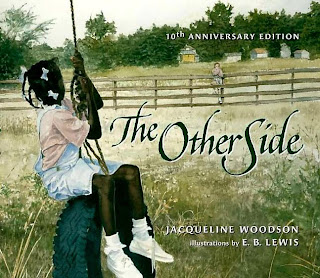PLOT: This is
a story about two little girls that are separated by a long fence between their
yards. Clover an African American little
girl lives on one side and Annie who is a lonely little girl lives on the other
side. Both Clove and Annie have been
instructed not to cross the fence.
However, Clover begins to see how lonely Annie is and she soon begins to
talk to her. One day Annie jumps over the fence to play with the other little
girls. Clover’s friends are not very accepting of Annie in the beginning but
they soon accept her as a playmate. Even
though they are not allowed to jump over the fence the girls learn that there
is no rule about sitting on the fence.
The fence is a symbolization of segregation but this obstacle does not
stop the girls from becoming friends.
Woodson, J. (2001). The other side. New York: G.P. Putnam’s Sons.IMPRESSION OF THE BOOK: This book was a great read. I really enjoy reading historical fiction books, especially picture books. The illustrations in this book are beautiful. The books have a combination of realism and impressionism art which really gives the book a sense of a genuine historical setting. Clover’s character is strong and she comes across as a leader. In the beginning of the story Annie asks if she could play with the girls and Clover’s friend Sandra responded no, without even asking the rest of them. As the book continues Clover observes Annie even on the rainy days and realizes that Annie is very lonely. After the rain stops Clover decides to go to the fence and talk to Annie, they hit it off as friends, however, Clover’s friends are not so accepting. As Annie and Clover are sitting on the fence Sandra and the rest of the girls are giving them strange looks and are not very accepting of Annie. Clover turns and looks at them and ignores her friends and continues to talk to Annie as they sit on the fence. After this Clover’s friends are accepting of Annie and the friendship that Clover has created. Later in the story Clover’s friends allow them to play jump rope and all the girls learn to sit on the fence and hang out.
REVIEWS: Kirkus Reviews (January 1, 2001)
Race relations, a complex issue, is addressed in a simple manner through the eyes of two young girls, one black and one white, on either side of a fence that divides their yards and, in fact, the town. Both girls have been instructed not to go on the other side of the fence because it's not safe. Each stares at the other, yearning to know more, but they don't communicate. When Annie, the white girl, climbs on the fence and asks to jump rope, she is told no by the leader of the black group. The narrator, Clover, has mixed feelings and is unsure whether she would have said yes or no. Later, the girls, with their mothers, meet on the sidewalk in town, looking very much the same, except for the color of their skin. When asked why the mothers don't talk, the explanation is, "because that's the way things have always been." During the heavy summer rains, Annie is outside in her raincoat and boots, having fun splashing in puddles--but Clover must stay inside. When the rains stop, Clover is set free, emerging as a brave soul and approaching Annie in the spirit of her freedom. Eventually, the story finds both girls and all of Clover's friends sitting on the fence together, kindred spirits in the end. "Someday somebody's going to come along and knock this old fence down," Annie says. What a great metaphor Woodson has created for knocking down old beliefs and barriers that keep people apart. Children learn that change can happen little by little, one child at a time. Award-winning Lewis's lovely realistic watercolor paintings allow readers to be quiet observers viewing the issue from both sides. (Picture book. 5+)
Kirkus Review. (2001).
[Review of the book The other side, by Jacqueline Woodson]. Kirkus Reviews Issue. Retrieved July 11, 2013, from
https://www.kirkusreviews.com/book-reviews/jacqueline-woodson/the-other-side-6/
You can end the lesson by doing a hands
on project such as experimenting with water colors and painting your family or
have upper grades write a short story about how they make friends.

No comments:
Post a Comment